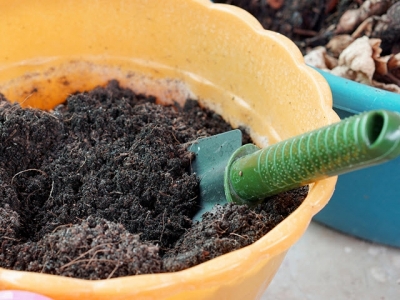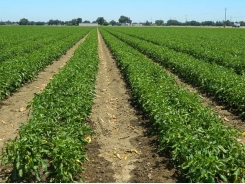Potting Soil Mix Explained: Ingredients and Labels

Potting soil mixes have many ingredients, and those ingredients are often labeled "natural" or "organic." But what does it all mean? Photo: By Snapholic / Shutterstock
If gardening in a container of any sort, most of us rely on a commercially produced potting mix to fill them. But should we? Here's a primer to the basic ingredients found in most potting soil mixes.
What Does “Natural “and “Organic” on a Potting Soil Mix Really Mean?
Not much, as it turns out. And on the whole, the ingredients of most off-the-shelf potting mixes are neither local nor good for the planet.
Most potting soil is “natural” in the sense that its ingredients are derived from naturally occurring substances. Seeing this label on a bag of potting soil by no means indicates it is been produced in an environmentally friendly manner. Similarly, many store-bought mixes are “organic,” but only in the sense that they are made from carbon-based substances, as opposed to inorganic—that is, inert—substances, like rocks.
These terms are plastered on a great number of potting mixes and soil amendments these days, but it’s important to realize that the USDA does not regulate the labeling of garden center products like it does organic food. The USDA plainly states that such products may be “labeled as ‘organic’ even if they do not comply with the standards to produce organic food.
Decoding Potting Soil Mix Labels
It’s difficult, if not impossible, to ascertain exactly what is in a potting soil mix, and the environmental implications of each ingredient, simply by reading the label.
“Compost,” for example, a common potting mix ingredient, doesn’t indicate what materials were composted. The term is often used for composted sewage sludge, which, as Mother Jones has noted, “can contain anything that goes down the drain—from Prozac flushed down toilets to motor oil hosed from factory floors. A 2009 EPA survey of sludge samples from across the US found nearly universal contamination by 10 flame retardants and 12 pharmaceuticals and exceptionally high levels of endocrine disruptors such as triclosan, an ingredient in antibacterial soap that scientists believe is killing amphibians.”
Luckily, even though the USDA doesn’t regulate how potting soil mixes are labeled, there are some third-party organizations that provide certification for potting mixes (along with fertilizers, soil amendments, and a wide variety of farm and garden products) that are free of synthetic substances and thus compatible with USDA organic standards.
These include the Organic Materials Review Institute (OMRI), the California Department of Food and Agriculture (CDFA), and the Washington State Department of Agriculture (WSDA). Look for the logo of one of these organizations when shopping for potting soil to know that the words “organic” and “natural” actually mean something.
Still, these designations only tell you that the ingredients do not include synthetic substances. It doesn’t mean they are sustainably-produced, and it certainly doesn’t tell you where they came from. Many potting soil ingredients, including those approved by the organizations above, cause some pretty horrific environmental damage and travel thousands of miles on their way to your garden.
Potting Soil Mix Ingredients and Their Environmental Implications
These ingredients are commonly found in commercial potting soils and recipes for DIY mixes. It’s next to impossible to produce potting soil that is 100 percent environmentally benign, but the following guide will help you weigh the pros and cons of each.
- Coco Coir: Coir (pronounced kwaher), This is simply shredded coconut husks from plantations in southeast Asia. While it is technically a waste product, the fact that coco coir is shipped from overseas gives it a high carbon footprint. Often used as a main ingredient in potting soil, coco coir is highly effective at retaining moisture.
- Compost: Homemade compost, comprised of kitchen scraps, garden trimmings, and manure, is probably the most eco-friendly and effect potting soil ingredient there is. The compost found in commercially available potting soils is often made from the waste products of forestry operations, and is often sourced regionally, making it a fairly low impact ingredient. Compost, while it is a spongy material, does not retain moisture as effectively as coco coir or peat moss, though it is much higher in nutrients than both of these ingredients.
- Kenaf: Kenaf is the waste product of a type of hibiscus grown for industrial fiber applications. Like rice hulls, it is a sustainable alternative to peat moss.
- Peat Moss: Long a primary ingredient in commercial potting soil, peat moss is increasingly being replaced with coco coir (both substances have similar water retention properties) as public awareness of its environmental impacts grows. Peat moss is harvested from deposits in northern bogs, where it accrues very slowly over centuries, and is being removed for horticultural uses faster than it can be replenished. Peat bogs are important habitats for plants and animals wherever they occur, but they also hold tremendous quantities of carbon dioxide, which is released into the atmosphere when the bogs are disturbed.
- Perlite: This is a volcanic mineral that has been heated to make it puff up like tiny bits of popcorn or Styrofoam. Perlite is added in small quantities to potting soil to improve drainage—it’s the little white flecks found in almost every commercial potting mix. It is extracted from open pit mines, with all the associated environmental impacts.
- Rice Hulls: This byproduct of rice production is an excellent alternative to peat moss for improving drainage, though it is not widely used in commercial potting soils. Specialty garden suppliers sometimes carry it as an ingredient for homemade potting mixes.
- Sand: Used to improve drainage, sand is rarely used in commercial potting soils because it is so heavy, but is a common ingredient in homemade potting mix recipes where weight is less of an issue. Large-scale sand mining is highly destructive, though if you have access to a river or creek, it’s easy to harvest your own without causing damage (avoid beach sand, as the salt it contains may damage your plants).
- Shredded Bark: This spongy material is largely used as filler in commercial mixes. A byproduct of the forestry industry (usually from pine plantations), this is a relatively low impact ingredient, especially if it comes from a local source.
- Soil: Commercial potting mixes are often advertised as soilless simply because dirt is heavy and inhibits drainage. Though when incorporated in limited quantities, garden soil is a useful and highly sustainable ingredient for homemade mixes, especially if you use fertile, crumbly topsoil.
- Vermiculite: This mica-like mineral is sometimes added to improve drainage. But like perlite, it comes with all the environmental implications of mined materials.
- Worm Castings: This compost-like material is essentially worm droppings, and may be produced in a home worm bin or through commercial-scale worm composting. While quite expensive to buy, worm castings are an ideal potting soil ingredient, with minimal environmental impacts.
Có thể bạn quan tâm
Phần mềm

Phối trộn thức ăn chăn nuôi

Pha dung dịch thủy canh

Định mức cho tôm ăn

Phối trộn phân bón NPK

Xác định tỷ lệ tôm sống

Chuyển đổi đơn vị phân bón

Xác định công suất sục khí

Chuyển đổi đơn vị tôm

Tính diện tích nhà kính

Tính thể tích ao hồ



 7 Perennial Herbs to Plant Now
7 Perennial Herbs to Plant Now  Understanding nitrogen fertilisation in vegetables – part 3
Understanding nitrogen fertilisation in vegetables – part 3